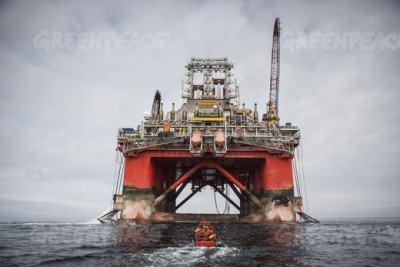After prevailing over active protests against its controversial drilling plans in the Arctic this summer, Norwegian oil company Statoil has had to admit at least commercial defeat. There wasn’t enough oil and gas found at its so-called “Hoop” field in the Barents Sea to justify development of the wells.

“We are naturally disappointed with the results of this summer’s drilling campaign in the Hoop area,” said Statoil’s senior vice president for exploration on the Norwegian continental shelf, Irene Rummelhoff, in a prepared statement.
Environmental activists at Greenpeace, however, were relieved and glad. The licenses issued to conduct the oil and gas exploration in the fragile Arctic enviroment “should never have been awarded in the first place,” said Truls Gulowsen, head of Greenpeace in Norway. “When all these wells turned up uncommercial, it is safe to say the birds at Bear Island (Bjørnøya) were victorious.”
Greenpeace activists from around the world launched a major protest against Statoil’s drilling project last spring, occupying its drilling rig Transocean Spitsbergen and later positioning its Greenpeace vessel at the first drilling site at Hoop, in an effort to halt the project. Greenpeace ultimately had to give up its protests but remains geared to fight other exploration and especially extraction efforts in the Arctic.

Oil industry officials, however, feel obligated to continue their efforts to find and produce more oil and gas, with Norwegian firms claiming they’re trying to secure Norway’s future as an energy nation. They’re under more pressure now, given other disappointing drilling results recently and the high costs and risks of extraction so far north.
“‘Uncertainty’ is the key word now,” Klaus Mohn, a professor at the business school at the University of Stavanger in Norway’s oil capital, told Norwegian Broadcasting (NRK) on Friday. “Exploration results have been disappointing. Oil companies in the Barents Sea hope first and foremost to find oil, because it’s easier and cheaper to extract, but so far they’ve found gas, which is expensive and demanding both to develop and market.”
After a string of promising discoveries a few years ago, the oil companies have lately been coming up dry. Mohn told NRK that unless some new drilling efforts strike oil, the oil and gas “adventure” in the Arctic may be over before it really gets underway.
Rummelhoff at Statoil noted that the Hoop area, though, is a “frontier” covering more than 15,000 square kilometers with only six wells completed to date. “So we do not have all the answers about the subsurface yet,” she said. “Non-commercial discoveries and dry wells are part of the game in frontier exploration. They provide important knowledge about the area.”

Statoil isn’t showing signs of giving up after the Apollo, Atlantis and Mercury wells were drilled this summer at Hoop. Statoil and its partner, the Japanese firm Idemitsu Petroleum Norge, reported a “small gas discovery” at the Mercury prospect. “We will now analyze the data we have acquired in the wells and incorporate it in our subsurface models,” Rummelhoff said. “We have confirmed a working petroleum system in Hoop … (and) know from experience that exploring for hydrocarbons in the Barents Sea takes time and stamina.”
Gulowsen and his colleagues at Greenpeace are unlikely to give up either, continuing to claim that an oil spill in the Hoop area “could have fatal consequences for the wildlife and the pristine nature, especially close to the nature reserve of Bear Island.” For now, though, Gulowsen said the “ice edge is not threatened by oil spills this fall. The Arctic itself is resisting the oil companies’ intrusion.”
newsinenglish.no/Nina Berglund

